Batelle Darby Metro Park and Cedar Bog State Nature Preserve
Part A: Geobotany of Ohio
Ohio’s geology can be divided into two parts; western and eastern. Due to erosions of the rocks, the landscape of the Western part became completely flat. This area is underlain by limestone which is a common type of carbonate sedimentary rock. As for the Eastern part of Ohio, the landscape is supported by sandstone which is a classic sedimentary rock made of sand like pieces of rocks and minerals. Due to the rocks, resistant features. it takes significantly more time for this landscape type to erode. The Cleveland region’s sandstone capped hills are great examples for the strength of these rocks.
Originally, there was a horizontal sequence of sedimentary rock strata with thick layers of limestone which was overlain by sandstones over the years. Before erosion this rigid structure tilted into a form of low arch. This process contributed to the generation of the Appalachian Mountains in the east of the US. The arch was the lowest in the east causing mos of the sandstone remained there.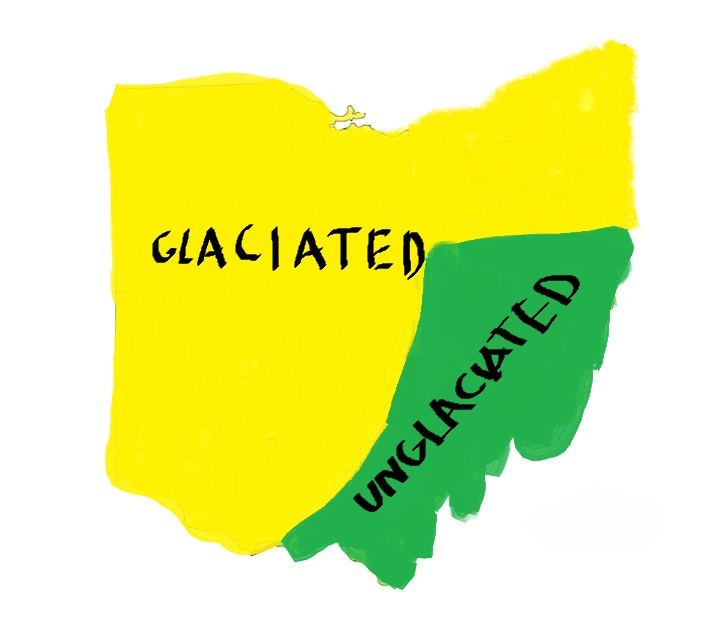
Most of the erosion in western and eastern Ohio was created by the famous preglacial stream, namely the Teays River. The river started to erode this area 200 million years ago and it continuously cause changes to the area. Landscape changes continued with glacier movements that started during the Ice Age and ended 20,000 years ago. The changes were slowed down by the sandstone hills of eastern Ohio during the last glacier movement because there in this area there was nothing to hinder the advance of the ice. This is mostly because there is significant difference between the sandstone and limestone structures. Furthermore, the difference contributed to the creation of a sharp glacier boundary shown in the image above. Depositions by the glaciers were left behind which is called till and it is accumulated by the melting of the ice. The definition of till is “an unsorted mixture of sand, silt, clay and boulders”. Sand and grave materials also deposited in this area but by the glacial melt water. A large difference between eastern Ohio’s and western Ohio’s landscape is that in western Ohio, the glacial till remained high in limestone and clay, however, the till of the eastern region is low in limestone and clay. The glacial out wash not only caused important changes in both region’s landscapes but it also deposited glacial sand and gravel to all areas of Ohio. Thus, the western regions of Ohio especially flat regions have much limestone and clay till substrate. This caused the pH to increase and become less acidic compared to the east regions where the soil pH is more acidic.Usually, at places where the sandstone is mantled by till, the amounts of clay and lime in the till result in less acid, more moist, and more nutrient-rich soils. As an example, one of the sites we visited, namely Cedar Bog is a calcareous fen that has a neutral pH. Furthermore, the western regions of Ohio are quite poorly drained and inadequately aerated. As for the eastern Ohio regions, the soil is more permeable sandstone bedrock which generates a more acidic substrate. Thus, we can find different types of plants with varying substrate requirements and tolerances in the eastern and western parts of Ohio.
The American sycamore (Platanus occidentalis)

The American sycamore is monecious mensing it has both male and female flowers on the same tree. It is a wide canopied, deciduous tree, usually 75-100 ft. tall. It tend to have massive trunk and open crown of huge, crooked like branches. It’s leaves are broadly ovate or broader, blade often wider than long, long pointed. It’s habitat includes wetlands and riparian zones, as well as the interference between land and a stream or river. Interestingly, the American Sycamores is also known as “ghost tree” because of their white branches in the upper part of the crown, resulting from leaves falling from them. This feature of the tree ads to its eye-catching appearance.
Crack willow (Salix fragilis)
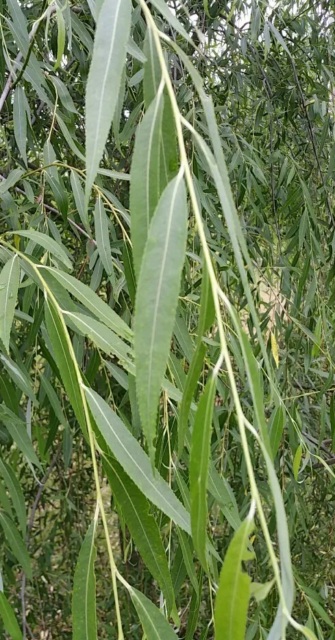
Crack willow (Salix fragilis) is a tree that has a dark brown bark and which develops fissures with age. It’s twigs are slender, flexible and shiny yellow brown. The leaves of crack willow is usually hairless and shiny on top and sparsely hair below. Its leaves are alternate, narrowly lance-elliptic, widest below or near the middle, wedge-shaped to somewhat rounded at the base. The upper surface is dull or shiny, medium to dark green. The Crack willow’s fruit is hairless capsule 4 to 6 mm long but viable seed is rarely formed. This plant mostly grows in light (sandy), medium (loamy) and heavy (clay) soils that are acid to neutral and disturbed areas with moist soils. Its reproduction mostly happens vegetatively by twigs breaking off and taking root, and from root suckers.
Black willow (salix nigra)
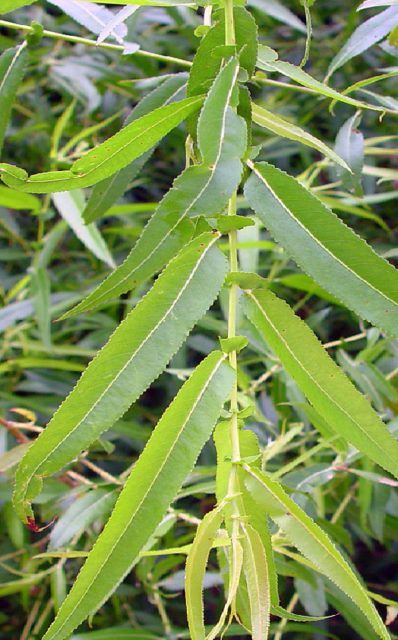
Black willow (salix nigra) is a species in willow native to Eastern America. It has bright yellow-green twigs bear yellowish catkins and it’s bark is deeply furrowed. The flowers of Black willow is inconspicuous, arranged in elongate clusters which appear in March and April. Usually the male and female flowers are found on separate trees. It’s seeds are wind-borne on silky hairs. The Black Willow’s leaf is alternate, simple, pinnately veined, and about 3-6 inches long. I found these leaves dark and shiny at the top and lighter green below. The spices usually found on moist or wet soils along banks of streams, lakes, and pasture sloughs. I found an interesting fact about the Black willow. The plant itself can be extremely tolerant of flooding and can withstand burial by sediments accompanying big floods. This is because it’s root system stabilizes the tree in the shifting soil. Thus, the Black willow is often used by scientists to control erosion.
Eastern Cottonwood (Populus deltoides)
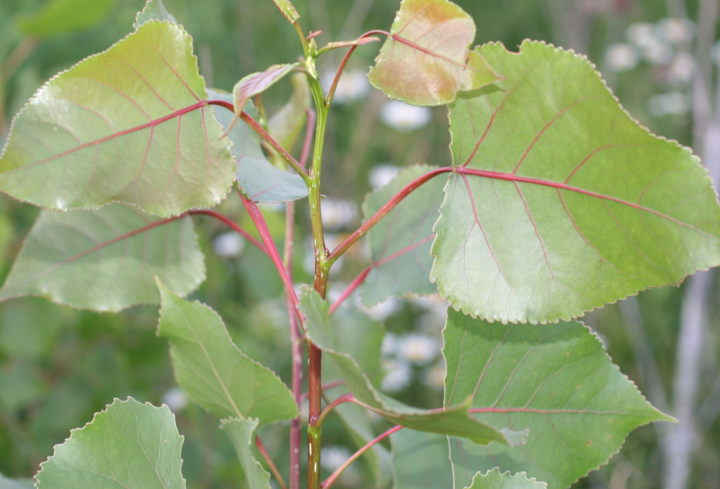
The Eastern Cottonwood (Populus deltoides) is a large. fast grwoing tree ususally found along lowland areas. It is characterized with alternate, simple, single toothed, triangle shaped leaves. The flowers of cottonwood are dioecious separate male and female plants, and occur in early spring before leaves emerge. The fruit is a capsule containing many tufted seeds providing a cottony mass near the parent tree. It grows on droughtu uplands, to moderately wet soils. The wood of Cottonwood is light and pale in color but it is usually without distinctive grain.
Big Bluestem (Andropogon gerardii)

The Big Bluestem (Andropogon gerardii) is a warm season plant with blue green stems 4-8 ft tall. It’s a perennial grass that not usually have rhizomes present on it. Its’ seadhead is usually branched into three parts and resembles almost like a turkey’s foot. The plant tolerates a wide range of soil types including poor soils, fertile, and well-drained soils. Interestingly, researchers and ecologists tend to use this grass for prairie restorations, naturalizing areas for nesting birds, and mammals screenings. Furthermore, the plant can be used for erosion control.
5 species of trees/shrubs that have a distribution generally limited to limestone or limey substrates;
- Eastern Redbud (Cercis canadensis)
- Blue Ash (Fraxinus quadrangulata)
- Eastern Hop Hornbeam (Ostrya virginiana)
- Hawthorn (Crateagus mollis)
- Eastern Red-cedar (juniperus virginiana)
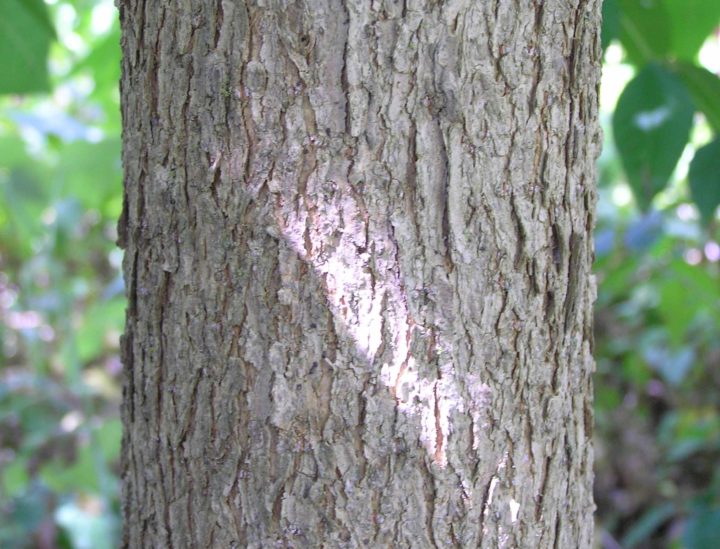
Blue Ash (Fraxinus quadrangulata)
The blue Ash has square edges of its branches with a swwaure cross-section. Its leaves are opposite, pinnately compound, and have 7 to 11 leaflets. They tend to be ovate shaped and are long pointed with finally serrate margins. It is a medium sized tree with an average high of 50-75 feet.

Eastern Redbud (Cercis canadensis)
The Eastern Redbud is a small deciduous tree. Typically grow 20 feet in height with similar spread and have gracefully ascending branches and a rounded shape. Its leaves are alternate, simple, broadly heart-shaped and 3 to 5 inches high and wide.
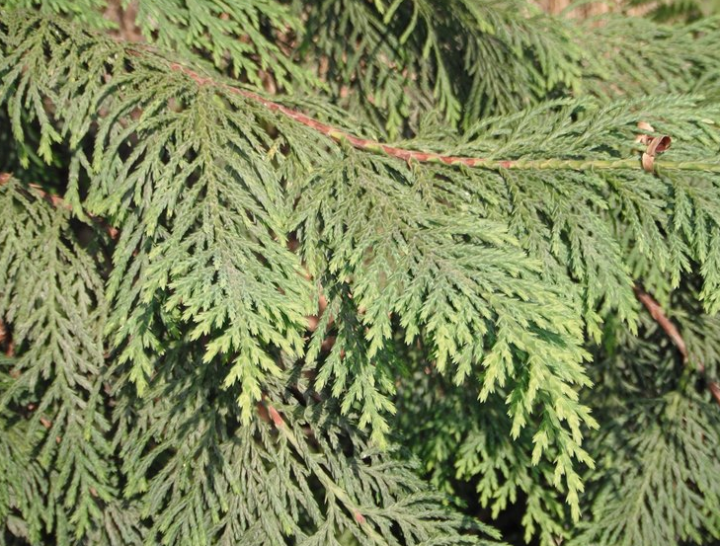
Eastern Red-cedar (juniperus virginiana)
Eastern Red-cedar is a small conical tree that has two types of leaves: spreading prickly ones on young shoots and seedlings and thightly overlapping scale like leaves on the mature branches. ITs habitat includes forests, meadows and fields.
5 Species of trees/shrubs that have a distribution generally limited to high- lime, clay-rich substrates developed in the thick glacial till of western Ohio:
- American Hornbeam (Carpinus caroliniana)
- Beech (Fagus grandifolia)
- Red Elm (Ulmus rubra)
- Prickly-ash (Zanthoxylum americanum)
- White Ash (Quercus alba)
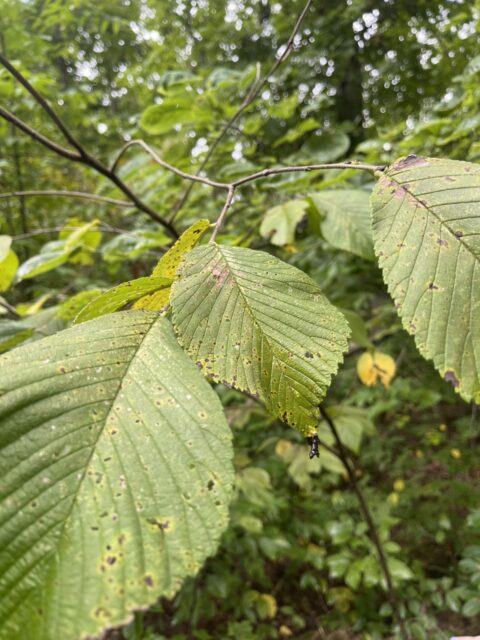
Red Elm (Ulmus rubra)
The Red Elm is a fast growing tree with leaves (48inch long). These leaves are alternately arranged, simple, broad oblong to obovate in shape with serrate margins. The leaves further have a sandpaper texture which I was fortunate to touch on our field experience. This tree prefers moist, rich soils of lower slopes and flood plains but it can also grow on dry hillsides with limestone soils.
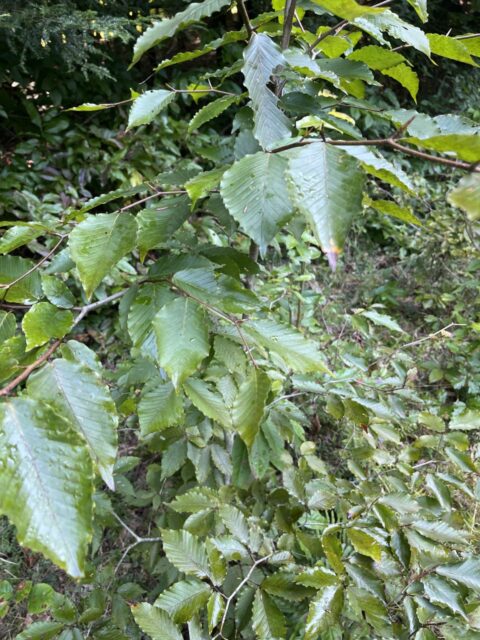
Beech(Fagus grandifolia)
Beech is a tall growing tree with round-headed and wide spreading structure. The thin bark is smooth and steel-gray in color. It also has toothed parallel-veined leaves which are shiny green and borne alternately along the stem. Habitats include rich mesic woodlands, wooded slopes, and better drained areas in swamps.

Prickly-ash (Zanthoxylum americanum)
The Pickly-ash’s bark is often knobby and armed with thorns. It has compound leaves that are positioned alternately along the stems and have three or more leaflets. The plants have small greenish flowers and fruits that consist of groups of two valved capsules. Habitats include woods and thickets, it also tolerates shades and drier upland soils.
5 species of trees/shrubs that have a distribution generally limited to sandstone hill of eastern OH
- Hemlock (Tsuga canadensis)
- Sourwood (Oxydendrum arboreum)
- Mountain Laurel (Kalmia latifolia)
- Mountain Maple (Acer spicatum)
- Chestnut Oak (Quercus montana)
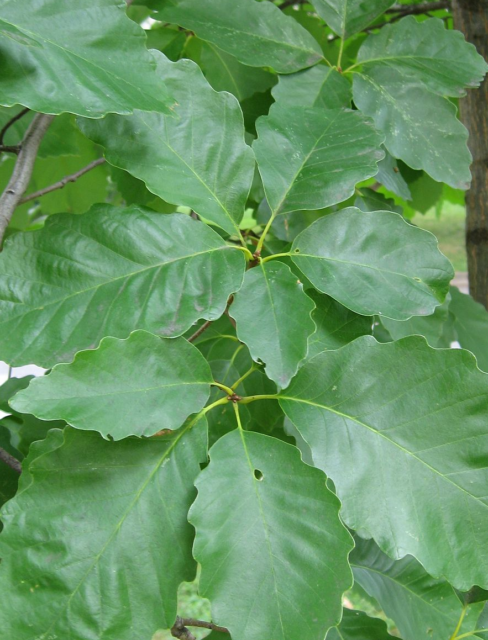
Chestnut Oak (Quercus montana)
Chestnut Oak is a deciduous, native tree which reaches 50 to 60 feet in height with an equal spread when grown in the open. It is capable of surviving on steep, rocky sites where other oaks in its range cannot. It has long, chestnut-shaped leaves that become dark yellowish-green in summer and change to orange-yellow in the fall.
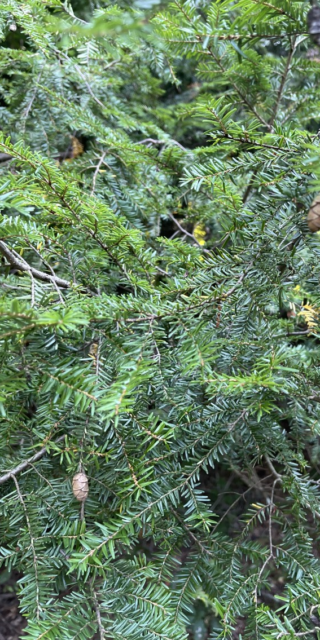
Hemlock (Tsuga canadensis)
The Hemlock is a tall pyramidal tree with purplish or reddish brown bark, slender horizontal or dropping branches, and short blunt leaves that grow woody cushion like structures on its twigs. There are small cons hang from the branch tips and retain their scales when they fall. In my opinion, this plant may be one of the most beautiful conifers, because of its soft green needles attached to gently arching branches.
The distribution of sweet buckeye (contrast with hemlock), hemlock contrast with sweet buckeye, rhododendron:
The Hemlock (Tsuga cabadebsis) and the Sweet Buckeye (Aesculus Flava) are plants that can be mostly found in the southeastern part of Ohio. The reason for their particular appearance is due to their preference for unglaciated regions. The erosion of sandstone thousands of years ago formed deep ravines which provide cooler climates, moist environment, and rainy weather. These features of the southeastern part of Ohio what is being favored by the Hemlock. This plant can also be spotted in Eastern areas of Ohio because the north of the glacial boundary has a less acidic soil with cool moist and valleys that provides enough substrates for the plant. The Sweet Buckeye favors these areas because it is unable to reproduce in areas where glacial till appears. Glacial till containing areas tend to be high in limestone levels. The Rhododendron mostly exists on the south of the glacial boundary, however, it cannot be found in areas north of the boundary. The reason for this unique appearance is explained by the Teays river drainage. When the glacier motion changed the environment, the plant used the river to migrate to the south portion of the Appalachian Ohio. The plants stuck in this region after the glaciers caused the Teays river blockage.
Part 2: Cedar Bog (that isn’t a bog)
The Cedar Bog State Nature Preserve is a protected area of abut 450 acres of land which remaons from the original area of approx. 7000 acres. The Cedar Bog is actually a “fen” and not a bog. Let me explain why. A fen is a wetland area that drains water, wheres a bog retains water. As for the fen, water usually enters the fen by rain and its surface runoff from uplands, underground springs from glacial movements as well as from deep groundwater leftover from the Teays River. Finally the water leaves the fen through small and tiny streams which flushes the system. Learning about this process really amazed me. The neutral pH of the soil is mainly determined by the water that leaves the fen as it dissolves the limestone.On the other hand, the bog is described as a structure in which the water usually enters by rain and surface runoff, but the only way for the water to escape is through evaporation. This causes the dead plants to pile and store up on themselves which causes the formation of peat. As the mater of plants decompose, this layers becomes acidic and it will have a much lower pH than the fen has. Since the fen is always flowing due to groundwater from glacial deposits, it is also not as affected by drought. Furthermore, Cedar Bog has it’s own micro climate that is akin to the average weather of the north part of the lower peninsula of Michigan. Thus, most of the species in the fen environment are normally located in range farther north. The Cedar Bog was formed around 14,000 to 18,000 years ago when the glaciers melted and filled depressions with dirt and limestone gravel. The materials for my summary on the Cedar Blog is obtained from the official website of Cedar Bog which you can visit by using the link.
The discovery made fulfilling the “scavenger hunt” assignment
Multiflora Rose (Rosa multiflora)
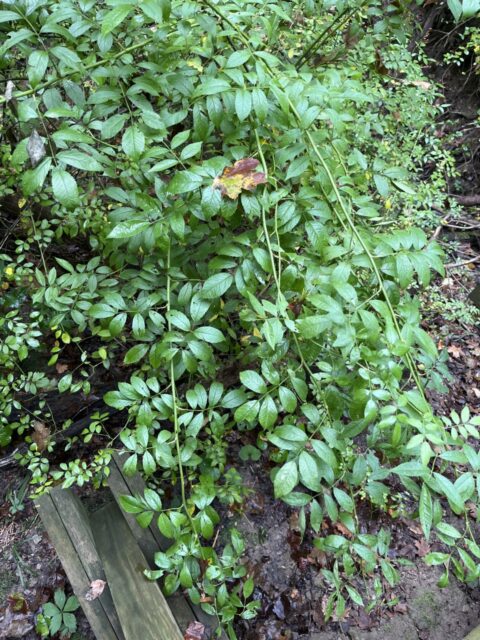
My assignment required me to find plants with alternate leaves. The first plant that I spotted with alternate leaves was the Multiflora Rose (Rosa multiflora) which is an invasive plant. This plant is perennial with woody stems and 3-6 feet tall. It has terete hairless stems that are heavily armed with stout curved thorns. These thorns are initially green, but eventually turn brown and woody. The plant has also have alternate compound leaves that are odd pinnate with 5-9 leaflets. These leaflets are medium to dark green, hairless, ovate and with serrated margins. The flowers have a typical rose-like fragrance. Fertile flowers are replaced by small rose hips that turn orange-red with maturity. Since it has a preference to partial sun, mesic conditions, and fertile loamy soil you can mostly spot them in open sunny sites. Habits also include woodlands, thickets, along rivers, and fence rows. The Multiflora Rosa is a major invader of both natural and disturbed areas. Interestingly, the book “Multiflore Rose for Farm Hedges” talks about the most important use of this amazing plant in the early 20th century. The in the 1930s, the Multiflora rose was promoted as and excellent tool to prevent erosion and technically create living fences.
Prickly Ash (Zanthoxylum americanum)

The next plant I spotted was the Prickly Ash (Zanthoxylum americanum) which is a thicket-forming shrub to 10 feet high, often densely branched above the middle. This plant formes thickets by sending up shoots from the underground, creeping stems called rhizomes. It’s leaves are alternate, pinnately compound, aromatic with 4-12 inches long. The bark of this plant is smooth, gray to dark brown with lighter blotches and scattered, small, light-colored lenticels. The twigs of this plant is rigid, smooth, dark brown to gray. It also has fragrant, individual flowers that are short-stalked. It prefers areas with woods and thickets and tolerates some shade and drier upland soils. Interestingly, the article “Insect Repellents from the Chinese Prickly Ash Zanthoxylum americanum ” talks about the benefical use of this plant. The bark of the plant is used to make medicine and it can also be used for insect repellents. For example, it is a great medication for menstural cramps, blood circulation problems in the legs and in the fingers.
Conservative Species
The C-value is a number between 0-10 assigned to individual plant species by a panel of experts with knowledge of the native flora of a particular region. Here are 4 examples of plants with different CC values.

Poison sumac (Toxidendron vernix) The plant has a CC value of 7.
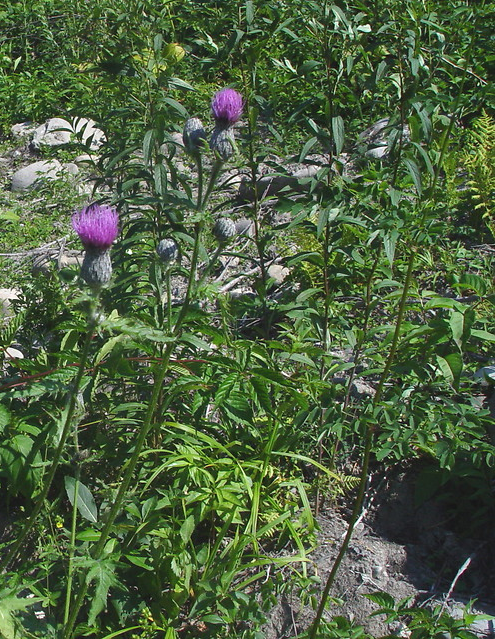
Swamp Thistle (Cirsium muticum) The plant has a CC value of 8.

Ohio goldenrod (Solidago ohioensis) with a CC value of 9. Thus, it can only be found in very few places of Ohio.
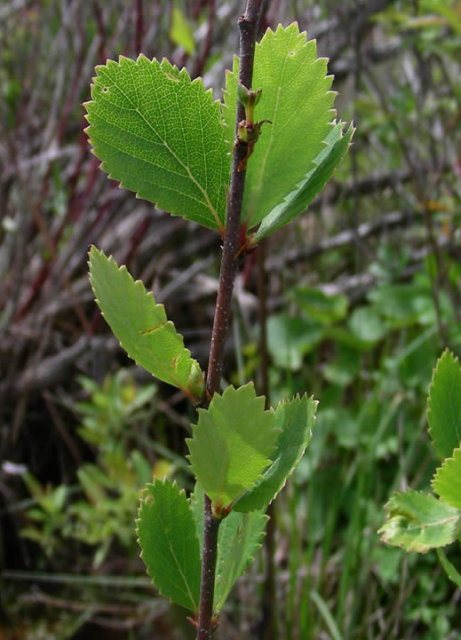
Swamp Birch (Betula pumila) which has a CC value of 10.
